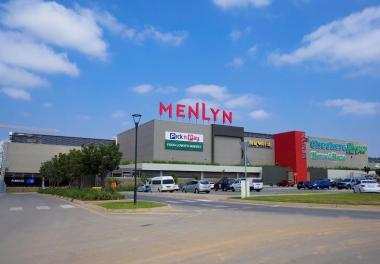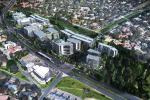Menlyn Park Shopping Centre earns green star rating
 The R2 billion extension of Menlyn Park Shopping Centre in Pretoria has received a 4-star green star retail design rating
The R2 billion extension of Menlyn Park Shopping Centre in Pretoria has received a 4-star green star retail design rating
The extension of Menlyn Park Shopping Centre in Pretoria has received a 4-star green star retail design rating ahead of World Environment Day.
Certified by the Green Building Council South Africa (GBCSA), the extension forms part of the R2 billion redevelopment of the centre, which began in 2014.
Due for completion in November this year, the shopping centre will become the largest centre in Africa, with over 500 shops and a trading area of 170 000m2.
Significant undertakings were implemented to achieve the rating for this phase of the development. Amongst others, use of post-consumer recycled reinforcing steel, ordinary cement in concrete was reduced by 30% through substitution with fly ash; more than 70 % of waste was repurposed; and cyclists are given dedicated parking bays and showers to encourage cycle use rather than emission-heavy alternatives.
Potable water consumption in the phased section was also reduced by approximately 70% in comparison to a conventional building of this type.
“This is a significant achievement for the South African retail sector as it opens the way for other centers to follow suit,” says Yovka Raytcheva-Schaap, Associate in the Buildings Unit of Aurecon South Africa.
Similar to the Green Star office rating system, the retail center rating tool assesses the environmental performance of the building in eight categories, including management, indoor environment quality, energy, transport, water, materials, land-use ecology and emissions. The retail sector, however, has been lagging in the application of the Green Star tool for rating of projects in comparison to the office buildings sector.
“Given the nature and the size of the project, the certification process was time and detail intensive, which entailed us working closely with the GBCSA on a number of aspects to attain the targeted points in the various categories,” says Yovka Raytcheva-Schaap.
The design of the reconfigured centre includes facilities for alternative transport, preferential parking for fuel-efficient vehicles, and integration into the region’s mass public-transport system.
“We wanted to reward our customers and tenants for using alternative transport,” says Marius Muller, CEO of Pareto Limited, owner of Menlyn Park Shopping Centre. “For example, we provided parking bays for scooters or motorbikes close to mall entrances to incentivise people to be part of our low-carbon-emission philosophy.”
Disposal of waste
Use and disposal of waste was another key issue. “It was essential that waste from pre-construction and construction was either reused or recycled,” explains Graham. “We made mulch from wood offcuts, for example, while surplus building materials, such as bricks, were ground down to be used for landscaping or fill.”
Efficient water use involved several strategies. “The municipal water consumption had to be limited” says Raytcheva-Schaap. “And so we implemented a number of initiatives to optimise the water performance of the centre, of which the most notable are rain water harvesting system with extensive capacity and water wise landscaping. In addition, low flow sanitary fittings and metering of the major water uses for continuous monitoring contribute to reduction of municipal water use.
Other important aspects of an environmentally friendly building are access to daylight, connection to the external environment and air quality. “Many people don’t realise how instrumental fresh air is to your health and wellbeing,” says Raytcheva-Schaap. “We exceeded the minimum regulatory fresh air requirements set out by the South African Bureau of Standards (SABS) by 150%, ensuring optimal indoor environment quality which safeguards against any indoor air pollution.”
Ample access to daylight is made possible throughout the extension via the use of glass and skylights, creating a comfortable and health-wise building. In addition, paints, sealants, and adhesives with low or no volatile organic compounds (VOC) were selected in order to enhance the indoor environment quality.
Energy-efficient HVAC system
Energy consumption had to be reduced by approximately 50% when compared to a reference building with design properties as stipulated in SANS204, which would also contribute to lower greenhouse-gas emissions.
The Mall installed an energy-efficient heating, ventilating and air-conditioning [HVAC] system,” says Aurecon mechanical engineer Brandon Huddle.
“The chilled water air-handling units run on a 100% full outside air economy cycle when the conditions are favourable and have CO2 monitoring for demand controlled outdoor air, which results in a massive reduction in energy usage by the building. Large fans and chilled water pumps make use of variable speed drives which allows only the optimum quantity of air and water to be delivered in order to meet minimum building demands, which reduces unnecessary motor energy consumption. Thermostatically controlled variable air volume dampers in turn deliver only the necessary quantity of air required by the shop based on the heat load which prevents over supply of air into the shops.”
Menlyn Park runs all proficient lights on occupancy and time controls, which are monitored through an integrated building management system, ensuring energy levels are checked regularly for any incongruities.
“We’ve made a commitment to reduce, reuse, recycle and rethink waste,” says Muller, “and this requires that at Menlyn Park we move away from traditional solutions that focus on waste after it has been generated, to a greener approach that looks at the prevention of waste, as well as minimising waste as a by-product of production.” To this end, a waste and recycling management plan (WRMP) was put in place at the shopping centre, to manage the collection, storage, treatment and disposal of all waste. The end goal is to recycle 57% of waste generated, which will ultimately result in diverting up to 80% of waste produced away from landfill.
“This project took the work of many dedicated people, and we are elated to finally see all our hard work and many hours of planning acknowledged by this prestigious Green Star rating,” says Muller.


















